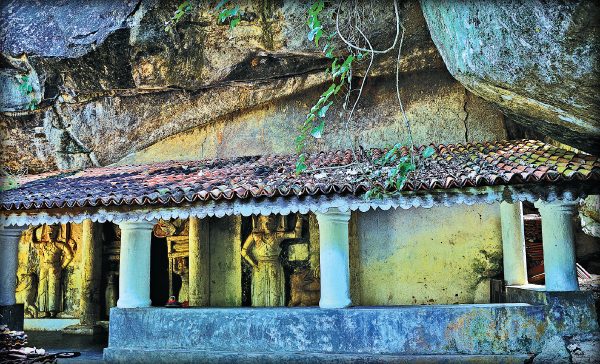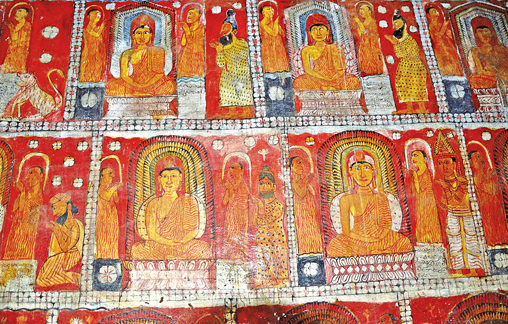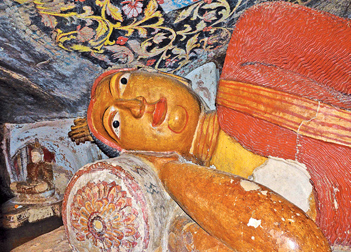|
Buddama cave temple:
Priceless repository of Kandyan art
Story and pictures by Mahil Wijesinghe
|

Exterior of the cave temple of Buddama
|
The second hand bookshops near Gamini Hall, located in close
proximity to my office, are a favourite haunt of mine. I go there at
least once a month, not so much for the rich variety of books offered at
reasonable rates, but for the rare books that one can find on various
subjects.
During my most recent visit, one of the bookshop owners, knowing well
my penchant for rare books, gave me an old magazine titled ‘Ceylon
Today’, published by the Ceylon Government Information Department in
1965.
It was a February issue, but what drew my attention to the magazine
was its cover photograph depicting the wall painting of the ancient
Buddama temple. The caption merely said, ‘Temple painting, Buddama,
Moneragala.’ But I knew its importance and decided to visit this
historically significant site that has been central to much of my work
as a photographer and explorer.
Accompanying me on my visit to the Buddama cave temple was Jagath
Sirisena, a Range Forest Officer from Moneragala, who is a young and
committed forest officer, whose range of coverage expands to Buddama.
The morning sun cast a warm glow as the vehicle slowly made its way
to the outskirts of the city. Instead of taking the main road, we took
the Mari Arava-Ritigahawatta secondary road to reach Buddama, which is
the shortest way to the site.
|

Wall paintings of Buddama |
We drove down the Mari Arava- Ritigahawatta road, past maize, peanut
and cow-pea fields turned right at Ritigahawatta Junction and travelled
past 10 kilometres of picturesque rural Uva-Wellassa to get to Buddama.
This region, which in the past was marked as a battle ground, was home
to Sinhala villagers who fought against the British rule in the 1818
Uva-Wellassa rebellion.
Buddama is a sleepy village bordering the Gal Oya National Park, and
is within shouting distance of many reservoirs such as Wadinagala,
Govinda Hela, Buddama Hela, Muthukandiya and the Meeyagala mountain
range from the North.
Chena cultivation is the main livelihood of the people of Buddama who
experience drought through most parts of the year. The region is roaming
ground for wild elephants, illegal loggers and treasure hunters who
ravage the remains of temples and forest reserves.
Destination
Having travelled around 40 kilometres from Moneragala, we reached our
destination and came upon the awe-inspiring sight of the historic
Buddama cave temple standing majestically on the foothills of Buddama
Hela. At the temple, we met Jayasuriya Banda, a secretary of the
devotee’s society of the Temple, who agreed to give us a guided tour in
the absence of the chief monk, who was out on official work.
Jayasuriya, whose knowledge of the Temple was extensive, took us
around, with the first stop being the main rock cave. It is a
drip-ledged cave not much in height, but a priceless repository of
Kandyan art. The entrance to the cave is decorated with the magnificent
and colourful Makara Thorana, built using clay. It is flanked by
guardian deities and lion figures, once painted in vivid shaded, lying
discoloured now.
|

The main reclining Buddha statue |
Entering the dimly-lit main chamber, we glimpsed a reclining Buddha
statue belonging to Kandyan period. This main statue is believed to have
been constructed by King Rajadhi Rajasinghe of Kandy. The main Buddha
statue had been damaged by treasure hunters on several occasions.
The rock ceiling of the cave is decorated with beautiful floral
motifs, while the murals offer a rich tapestry of Buddhist Jathaka
stories. At present, the murals are discoloured and have been left to
the mercy of the elements. The cave paintings at first glance do not
seem to be professional work, with the brush strokes ink lines showing
it to be the work of novices.
However, we found similar paintings in the image house in Udaganava
temple in Buttala, which had the same style as those as the Buddama
temple paintings. This leads one to believe that the paintings were a
modified form of Kandyan style, which had spread around Moneragala.
While looking at temple paintings in the main Buddama cave, I looked
for the painting captured on the cover of the ‘Ceylon Today’ magazine in
1965. And surprisingly found the painting intact.
One of the most striking features of the Buddama temple is its
Velipeella (the long narrow clay box strewn with sand). In ancient times
the Velipeella was used by monks to teach letters and letter writing to
pupils. Archaeological evidence is scant regarding the Velipeella in Sri
Lanka. However, the largest Velipeella is found in the Buddama temple.
Lying between two rocks just close to the main cave, the 18 feet long,
two feet tall Velipeella is a unique feature of the temple.
Hardships
|

The Velipeella used to practice letters in ancient Sri Lanka |
Seeing the Velipeella, I couldn’t help wonder about the hardships
pupils in the past must have undergone to become scholars, unlike today
when information comes at a push of a button.
Pointing toward the rocky outcrop, Jayasuriya said the temple
comprising more than 20 caves in the vicinity of the mountain had been a
vocational training centre for craftsmen before it became a monastery,
after the advent of Buddhism during the Anuradhapura period.
The early Brahmi inscriptions found in the temple indicate that the
cave was a donation to monks by a teacher named Gupta, a grandson of the
village councillor, Vasaba, son of Sumana in the 3rd Century. Although
the structures of the temple have been renovated from time to time, the
temple is attributed to King Rajadhi Rajasingha of Kandy. |

